|
Working DogsAccording to the American Kennel Club working dogs were bred to perform such jobs as guarding property, pulling sleds and performing water rescues. Quick to learn, these intelligent, capable animals make solid companions. Their considerable dimensions and strength alone, however, make many working dogs unsuitable as pets for average families. And again, by virtue of their size alone, these dogs must be properly trained. In the civilian world, some of the more well-known dogs in the working group include: Akita Including in the working dog group is the Akita whose temperament can range from calm to bouncy and aggressive, so the breed should always be supervised around small children and other animals. The Akita is popular in the show ring and also participates in performance and therapy work. This breed ranges in size from 24 to 28 inches tall at the shoulder. If you are interested in adopting an Akita, please see the list of Akita rescue groups throughout the United States. Photo by Rydden 213 Flickr 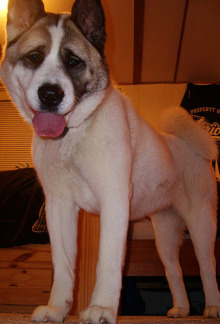
Bernese Mountain Dog Another type of working dog is one of four varieties of Swiss Mountain Dogs, the Bernese Mountain Dog. It is the only variety that possesses a long, silky coat. A hardy dog that thrives in cold weather, this dog’s intelligence, strength and agility helped him perform the drafting and droving work in the mountainous region where he originated. This breed ranges in size from 23 to 27½ inches tall at the shoulder. Their gentle, easygoing manner and the need to be close to people makes them a good fit for families. If you are interested in adopting a Bernese Mountain Dog, please see the list of Bernese Mountain Dog rescue groups throughout the United States and Canada. Photo by ShariF via Flickr 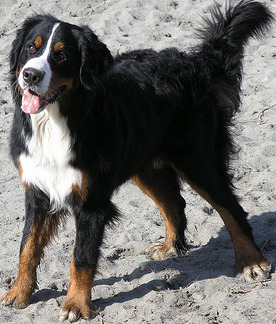
Boxer The Boxer is a highly recognized member of the working dog group. This breed is powerful and intelligent. He is known for standing up on its hind legs and batting at its opponent, appearing to box with its front paws. They are patient and spirited with children, but also protective, making them a popular choice for families. The Boxer requires little grooming, but needs daily exercise. They range in size from 21 ½ inches to 25 inches tall at the shoulder. If you are interested in adopting a Boxer, please see the list of Boxer rescue groups throughout the United States, Canada, and United Kingdom. Photo by John Wright via Flickr 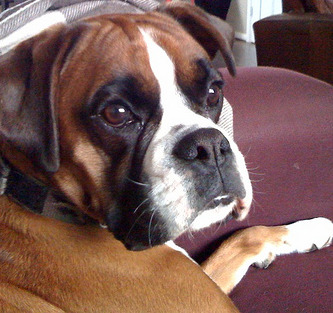
Doberman Pinscher You can imagine the Doberman Pinsher as a working dog, as he is often portrayed as a guard dog. This breed possesses great endurance and speed. The Doberman Pinscher is known to be energetic, watchful, fearless and obedient. He is affectionate, obedient and loyal. The breed requires regular exercise, but needs only minimal grooming for his short coat. They range in size from 24 to 28 inches tall at the shoulder. If you are interested in adopting a Doberman Pinscher, please see the list of Doberman Pinscher rescue groups throughout the United States. Photo by Pato Garza via Flickr 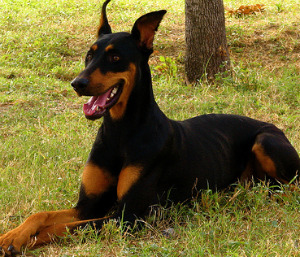
German Pinscher Medium-sized, the German Pinscher is an excellent watchdog and companion. This working dog is suitable for conformation, obedience, tracking, and agility competitions. They stand 17-20 inches tall at the highest point of the withers. They possess a natural instinct to hunt vermin and have a strong prey drive. They make a good companion and watch dog. If you are interested in adopting a German Pinscher, please see the list of German Pinscher rescue groups throughout the United States. Photo by Wonderlane via Flickr 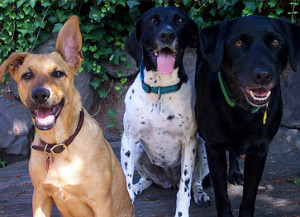
Great Dane Strong, friendly, and energetic describes this working dog breed, they make excellent family dogs. Standing 28 to 30 inches at the shoulder, this is definitely a giant breed. He was originally bred to hunt boar. If you are interested in adopting a Great Dane, please see the list of Great Dane rescue groups throughout the United States, Canada, and the United Kingdom. Photo by Mike McCaffrey via Flickr 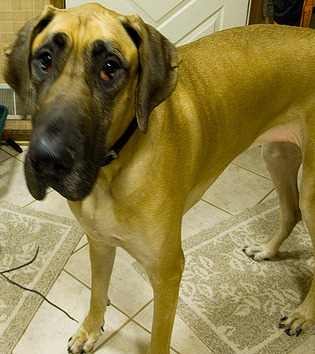
Mastiff The Mastiff is another of the working dog breed and loves being around people. This breed is known to bond closely with his family. The Mastiff is a powerful yet gentle and loyal companion, but because of his size; a minimum height of 30 inches tall at the shoulder for males and 27 ½ inches tall for females, and need for space, he is best suited for country or suburban life. The breed requires light exercise and minimal grooming. If you are interested in adopting a Mastiff, please see the list of Mastiff rescue groups throughout the United States and Canada. Photo by Flashbulb.memory via Flickr 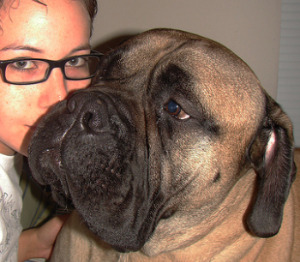
Newfoundland A master at long-distance swimming, this working breed has true lifesaving instincts in the water. He ranges in size from 26 to 28 inches tall at the shoulder and weighs 100 to 150 pounds. He has a thick coat that is water-resistant. This giant dog has a sweet disposition making him a good family pet. Although he appears somewhat docile, he is an active dog and will need daily exercise. If you are interested in adopting a Newfoundland, please see the list of Newfoundland rescue groups throughout the United States. Photo by Scott Feldstein via Flickr 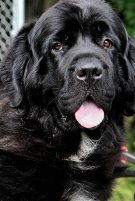
Saint Bernard Originally used to locate freezing and helpless travelers, during snowstorms, this working breed, the Saint Bernard now uses his intelligence and strength in conformation and obedience competitions, cart pulling and weight pulling. The breed ranges in size from 25½ to 27½ inches tall at the shoulder and weighs 130 to 180 pounds. These are great family pets but be prepared for lots of drool and shedding. If you are interested in adopting a Saint Bernard, please see the list of Saint Bernard rescue groups throughout the United States. (Links to other pages on Adopt the Right Dog and other sites open in a new window.) Photo by Rydden 213 viaFlickr 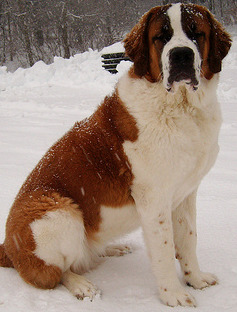
Military Working DogsThe vast majority of U.S. military working dogs in recent times are German and Dutch shepherds and Belgian Malinois, breeds chosen because they are very aggressive, smart, loyal and athletic. Trained beside their military handlers, military working dogs also serve beside them in military war zones. They are trained by the Department of Defense at Lackland Air Force Base in Texas to perform a variety of duties. The types of military war dogs include: Sentry Dogs These dogs are especially valuable for working in the dark when attack from cover or the rear is most likely. Sentry dogs are trained to warn their handlers of the approach or presence of strange persons and are utilized for guarding supply dumps, airports, war plants, and other vital installations. These dogs warn by growling, alerting or barking. Scout or Patrol Dogs These dogs are trained to work in silence to aid in the detection of snipers, ambushes, and other enemy forces within a particular locality. Scout dogs could detect the presence of the enemy at distances up to 1,000 yards, and notify their handler by stiffening their bodies, raising their hackles, pricking their ears and holding their tail rigid. Messenger Dogs They work with two handlers traveling quietly under natural cover between the two. Mine Dogs "M-Dog" or mine detection dogs, are trained to find trip wires, booby traps, metallic and nonmetallic mines. Casualty Dogs Like search and rescue dogs, are trained to search for and report casualties lying in obscure places. Explosive Detection Dogs Explosives Detection dogs are trained to alert on the scent of chemicals used in explosives. With their superior sense of smell it is very difficult to package explosives in a way a dog cannot detect. Retired military dogs are sometimes up for adoption. If you are interested in adopting a retired war dog, you may request an application. Please use the form provided on the following page. Before a dog is ready to enter the military training program, puppy foster care is needed. If you are interested in fostering a military puppy before he is old enough to enter formal training, you can learn more about it on my Foster a Military Dog page. (Links to other pages on Adopt the Right Dog and other sites open in a new window.) Photo by US Army via Flickr 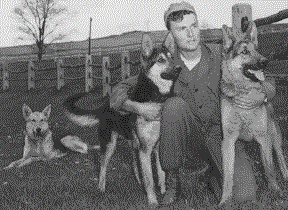
Police DogsTypical roles provided by police working dogs include searching for suspects and missing people, locating objects dropped or hidden during a criminal incident, tracking criminals, chasing and detaining a person who runs away when ordered to stop, disarming violent armed suspects, and controlling hostile crowds. Among the dog breeds that perform police work are the German Shepherd, the Doberman Pinscher, the Akita, and the Boxer. Police dogs are also used in drug and explosive searches and to find human remains or blood. Most of the dogs that are retired from their police duties due to age or injury remain with the police officer they've been paired with. Search and Rescue DogsWhen someone is reported lost or overdue, volunteer search and rescue (SAR) dog teams are available to respond. One of my favorite agencies is the Search Dog Foundation. This wonderful agency recruits rescued dogs and partners them with firefighters and other first responders to find people buried alive in the wreckage of disasters. They work with shelters, breed rescue groups and service dog agencies to recruit dogs that display an intense drive, athleticism, energy, and focus. Labrador Retrievers, Golden Retrievers, German Shepherds, and Border Collies are the types of breeds that have the necessary traits to do search and rescue work. These are true working dogs. There are several types of search and rescue dogs including: Air scent: This type of dog finds lost people by picking up traces of human scent that are drifting in the air. Trailing dogs: The trailing dog is directed to find a specific person by following minute particles of human tissue or skin cells cast off by the person as he or she travels. A Bloodhound is typically trained for scent discrimination Tracking dogs: A tracking dog is trained to follow the path of a certain person. It physically tracks the path of the person, without relying on air scenting. Disaster dog: A disaster dog is trained to find human scent in very unnatural environments, including collapsed structures and areas affected by tornadoes and earthquakes. Cadaver dog: A cadaver dog reacts to the scent of a dead human. The dog can be trained for above ground and buried cadaver searches. Water search dog: A water search dog is trained to detect human scent that is in or under the water. Avalanche dog: An avalanche search dog is trained to detect human scent that is in or under snow of up to 15 feet. For a variety of reasons, some of the dogs chosen for training do not complete the training, and these dogs need to be put up for adoption. If you are a resident of California and are interested in adopting one of these dogs, you may fill out an application at the Search Dog Foundation site. If you are interested in helping the Search Dog Foundation, they would appreciate your help spreading the word about their important life saving work, please see their flyer meant for distribution. (Links to other pages on Adopt the Right Dog and other sites open in a new window.) 
Assistance/Service DogsGolden Retrievers are often used as service and therapy dogs because of their gentle nature. Guide Dogs are usually German Shepherds, Labrador Retrievers, Golden Retrievers, & Labrador/Golden crosses. There are many types of assistance, or service, dogs that spend their days looking out for their owners. These true working dogs include: Seeing-eye or Guide Dogs - stays by its owner’s side while out in public and guides its owner around obstacles, stairs, and traffic. Hearing Dogs - alerts his handler to sounds, such as doorbells, phones, smoke alarms, tea kettles, timers, and a baby's cry. Seizure Alert/Response Dogs - responds when the handler has a seizure by getting help or staying by its owner. Mobility Assist Dogs (Service Dogs) - is the arms and legs for a disabled person, carrying backpacks, picking up things, opening and closing doors. Psychiatric Service Dogs - keeps a person with a psychiatric disorder calm allowing him to go out in public. Once these service or assistance dogs are retired due to age or medical reasons, they are sometimes put up for adoption. Also, some dogs enter a training program to be a service dog, but for one reason or another don't graduate. These dogs need to be adopted by a loving forever home. There are several agencies where you can inquire about adopting one of these special dogs. Following is a list of contacts:
Circle Tail Fabulous Flunkies (Links to other pages on Adopt the Right Dog and other sites open in a new window.) So now that you know more about working dogs, why wouldn't you want one? Helpful, strong, intelligent, and loyal, these dogs serve our military and police, assist our disabled, and make wonderful pets. And those that do serve or assist, deserve to live in comfort in their later years. Return from Working Dogs to Adopt the Right Dog Homepage
|





